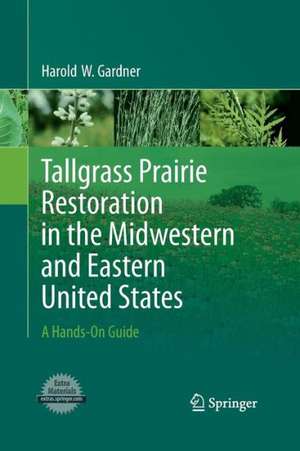Tallgrass Prairie Restoration in the Midwestern and Eastern United States: A Hands-On Guide
Autor Harold Gardneren Limba Engleză Paperback – 12 oct 2014
| Toate formatele și edițiile | Preț | Express |
|---|---|---|
| Paperback (1) | 1216.95 lei 6-8 săpt. | |
| Springer – 12 oct 2014 | 1216.95 lei 6-8 săpt. | |
| Hardback (1) | 1221.20 lei 6-8 săpt. | |
| Springer – 18 noi 2010 | 1221.20 lei 6-8 săpt. |
Preț: 1216.95 lei
Preț vechi: 1484.09 lei
-18% Nou
Puncte Express: 1825
Preț estimativ în valută:
232.89€ • 240.59$ • 193.83£
232.89€ • 240.59$ • 193.83£
Carte tipărită la comandă
Livrare economică 26 martie-09 aprilie
Preluare comenzi: 021 569.72.76
Specificații
ISBN-13: 9781489981752
ISBN-10: 1489981756
Pagini: 296
Ilustrații: XX, 276 p.
Dimensiuni: 155 x 235 x 16 mm
Greutate: 0.42 kg
Ediția:2011
Editura: Springer
Colecția Springer
Locul publicării:New York, NY, United States
ISBN-10: 1489981756
Pagini: 296
Ilustrații: XX, 276 p.
Dimensiuni: 155 x 235 x 16 mm
Greutate: 0.42 kg
Ediția:2011
Editura: Springer
Colecția Springer
Locul publicării:New York, NY, United States
Public țintă
ResearchCuprins
Table of Contents.- Preface.- Part I: introduction.- Chapter 1-Introduction to the Prairie.- Part III: Native Prairie Species.- Chapter 2- Mesic soil and adaptive species.- Chapter 3- Dry-mesic to dry soil preferring species.- Chapter 4- Wet-mesic to wet soil preferring species.- Part III: Restoration.- Chapter 5- Restoration methods.- Part IV: Management.- Chapter 6- Prairie Management.- Other Recommended.-Reading.- Glossary.- Index.
Textul de pe ultima copertă
Tallgrass Prarie Restoration in theMidwest and Eastern United States: A Hands-On Guide describes all aspects of restoring tallgrass prairie. Outlined are techniques from creating a prairie from scratch to improving diversity of existing prairies. The importance of selecting species for soil type is emphasized in this book. Methods are described for soil preparation, seed collection, seed treatment for germination, and planting rates. After creating a prairie, management is essential, such as safely conducting controlled burns and eliminating aggressive alien plants. Prairie restoration is essential, not only for aesthetic beauty, but prairies provide food for a variety of insects evolved to feed on our native plants. Insects in turn sustain a population of native birds, amphibians, and reptiles. Described in detail are over 200 species of grasses and forbs most commonly found in tallgrass prairies, most with accompanying photo illustrations. An appendix outlines about 900 additional species that are occasionally found on prairies. In addition, the Springer website illustrates detailed scanned herbarium samples and scanned seeds with accompanying seed-heads. These digitally scanned samples are invaluable for positive identification. This book is recommended for students, landscapers, horticulturists, hobbyists, and land managers.About the Author:Dr. Harold W. Gardner received a Ph.D. from Penn State University in biochemistry. His primary area of research was enzymatic oxidation of fatty acids, which serve as bio-signals in higher plants and fungi. Although his research took him to Hawaii, Sweden, California, and Illinois, he spent more than 30 years in Illinois where he became obsessed with attractive prairie eco-systems. Others joined him in prairie restoration efforts, eventually becoming known as the “Prairie Dawgs.” The Prairie Dawgs continue their dedication to prairie restoration in Illinois. Upon retirement to a farm in Pennsylvania, Gardner discoveredthat prairies also thrive in the East, where he manages about 20 acres of prairie.
Caracteristici
Discusses the origins of prairie millennia Highlights restoration methods Discusses Farming practices and global warming Includes supplementary material: sn.pub/extras











